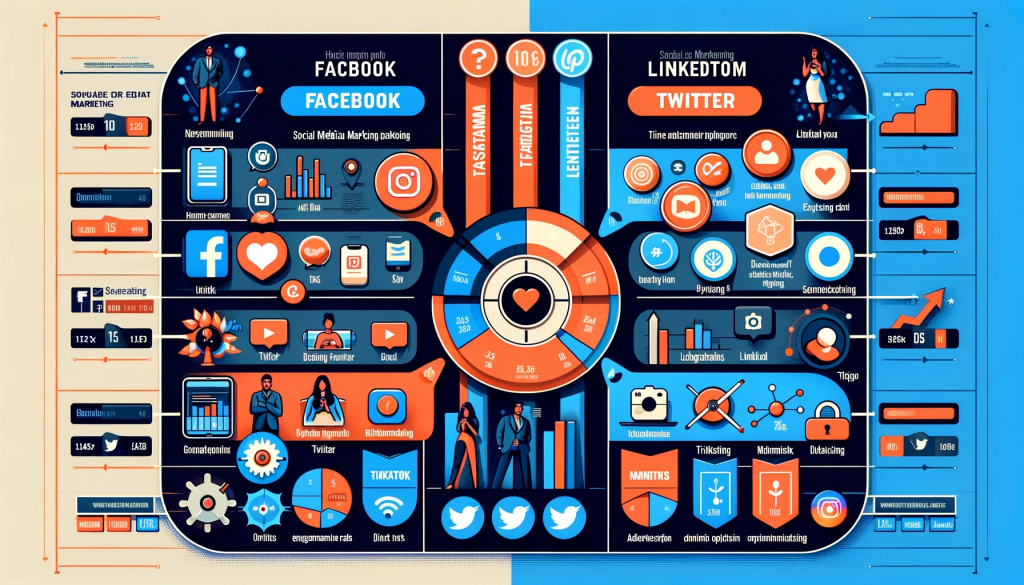Understanding Digital Marketing Strategy
The Evolution of Digital Marketing

The landscape of digital marketing has undergone a significant transformation over the years, evolving from basic online advertising to a comprehensive array of strategies that encompass a variety of channels and techniques. This evolution has been primarily driven by rapid technological advancements and changes in consumer behavior.
The earliest days of digital marketing can be traced back to the 1990s, with the advent of the internet and the first clickable banner ad in 1994. This marked the beginning of the digital advertising era. However, it was the introduction of search engines like Google and the rise of social media platforms that really changed the game. Businesses began to realize the potential of reaching a vast audience online and started to shift their focus from traditional media to digital platforms.
As technology continued to advance, so did the opportunities for digital marketing. The proliferation of smartphones and mobile devices opened new avenues for reaching consumers. Social media platforms evolved, offering more sophisticated tools for targeting and engagement. The rise of big data and analytics enabled marketers to gain deeper insights into consumer preferences and behavior, allowing for more personalized and effective marketing strategies.
Today, digital marketing is an integral part of any business strategy. It’s not just about having an online presence; it’s about creating a dynamic, interactive, and personalized experience that resonates with the target audience. The evolution of digital marketing has been marked by a shift from a product-centric approach to a customer-centric one, where the focus is on building relationships and providing value to the consumer.
Key Components of a Digital Marketing Strategy

Search Engine Optimization (SEO)
SEO remains a cornerstone of digital marketing strategy. It’s about more than just ranking high on search engines; it’s about being visible to the right audience at the right time. Effective SEO involves optimizing website content and structure to make it more attractive to search engines. This includes keyword research to understand what potential customers are searching for, creating high-quality content that addresses those needs, and ensuring the website is technically sound and user-friendly.
Content Marketing
Content marketing is about creating and sharing valuable, relevant, and consistent content to attract and retain a clearly defined audience. It’s not just about selling products or services; it’s about providing useful information that helps solve problems or answer questions. This can be in the form of blog posts, videos, infographics, podcasts, and more. The key to successful content marketing is understanding the needs and interests of your audience and providing content that engages and informs them.
Social Media Marketing (SMM)
Social media marketing is more than just posting on Facebook or Twitter. It’s about engaging with your audience, building a community, and creating a brand presence. Choosing the right platforms is crucial; where does your target audience spend their time? What kind of content do they engage with? Effective SMM involves a combination of organic engagement and targeted advertising, using the sophisticated tools provided by social media platforms to reach and engage the desired audience.
Pay-Per-Click (PPC) Advertising
PPC advertising is a model where marketers pay a fee each time one of their ads is clicked. It’s a way of buying visits to your site, rather than attempting to “earn” those visits organically. PPC campaigns can be highly effective if well-managed, targeting specific keywords related to your products or services. The key is in understanding your audience, choosing the right keywords, and crafting compelling ad copy that resonates with your target market.
Affiliate Marketing
Affiliate marketing involves partnering with individuals or other companies to promote your products or services. In return for their marketing efforts, affiliates receive a commission for each sale or lead they generate. This performance-based approach can be an effective way to extend your marketing reach without a large upfront investment.
Influencer Marketing
Influencer marketing taps into the power of social media influencers to promote products or services. These influencers have a large and engaged following, and their endorsement can significantly impact brand awareness and perception. The key to successful influencer marketing is choosing influencers whose followers align with your target audience and whose values align with your brand.
Crafting a Successful Digital Marketing Plan

Analyzing Your Audience
One of the first steps in crafting a successful digital marketing plan is to deeply understand your audience. This involves identifying the specific demographics of your target market, including age, gender, location, income level, education, and other relevant characteristics. Understanding your audience goes beyond just demographics, though. It’s about comprehending their behaviors, preferences, pain points, and motivations. Tools like Google Analytics, social media insights, and customer surveys can provide valuable data to help you create a detailed audience persona. This persona then guides your content creation, ad targeting, and overall strategy to ensure relevance and effectiveness.
Setting Clear Objectives and Goals
The foundation of any successful strategy is clear, measurable, and achievable objectives. These objectives should align with your overall business goals and should be specific, measurable, achievable, relevant, and time-bound (SMART). For instance, rather than setting a vague goal like “increase website traffic,” a SMART goal would be “increase website traffic by 30% over the next six months.” Your digital marketing objectives might include increasing brand awareness, generating leads, boosting sales, improving customer engagement, or enhancing online reputation. Clearly defined goals provide direction and a benchmark against which you can measure your success.
Selecting the Right Digital Channels
Digital marketing offers a plethora of channels, each with its unique strengths and audience. The key is to select the channels that best align with your objectives and target audience. This selection process involves an understanding of the various channels available – such as social media platforms (Facebook, Instagram, LinkedIn), email marketing, search engines (Google, Bing), and more. For example, LinkedIn might be more appropriate for B2B marketing, while Instagram could be ideal for a B2C brand focusing on visual products. The choice of channels also depends on where your audience spends their time and how they prefer to consume content.
Budgeting and Resource Allocation
Effective digital marketing requires a well-planned budget and efficient resource allocation. Your budget should reflect your marketing goals and the channels you have chosen. For instance, PPC campaigns might require a different budget allocation compared to content marketing or SEO efforts. It’s also important to consider the allocation of human resources – do you have the in-house expertise for your digital marketing efforts, or do you need to hire external agencies or freelancers? Monitoring the ROI of each channel and adjusting your budget accordingly is crucial for maximizing the impact of your digital marketing spend.
With these steps, you can lay a solid foundation for your digital marketing plan, ensuring that it is tailored to your audience, aligned with your business goals, and optimized for the best possible results.
Implementing and Managing Digital Marketing Efforts

Creating Engaging and Relevant Content
Content is king in the digital marketing realm. The creation of engaging and relevant content is paramount to attract and retain your audience, ultimately driving profitable customer action. This involves understanding what resonates with your target audience and providing content that solves their problems, educates them, or entertains. The content should not only be well-written but also well-designed, whether it’s blog posts, videos, infographics, or social media posts. Regularly updating your content keeps your brand relevant and helps maintain a connection with your audience. It’s also crucial to ensure that your content aligns with your brand’s voice and values for consistency.
SEO and Content Synergy
SEO and content marketing should work hand in hand. While SEO helps in making your website and content discoverable, good content holds and engages the audience. Integrating SEO involves researching and using the right keywords, optimizing meta tags, and creating quality backlinks. However, it’s not just about pleasing search engines but also about making your content valuable and enjoyable for your audience. The synergy of SEO and content marketing enhances your visibility and drives organic traffic, which is vital for long-term digital marketing success.
Leveraging Social Media for Brand Building
Social media platforms offer a unique opportunity to build your brand and engage directly with your audience. To effectively leverage these platforms, it’s important to understand which channels your target audience uses most and what type of content they prefer. Develop a consistent posting schedule and maintain an active presence. Engage with your audience through comments, messages, and interactive content. Use storytelling to make your brand more relatable and memorable. Additionally, social media can be used for customer service, providing a platform for addressing customer concerns and feedback.
Email Marketing Strategies
Email marketing remains a highly effective digital marketing strategy when done right. It involves sending emails to a list of subscribers who have expressed interest in your brand or products. The key to successful email marketing is personalization and segmentation. Tailor your emails to meet the specific needs and interests of different segments of your audience. Ensure your emails are visually appealing, have compelling subject lines, and provide value, whether it’s informational content, special offers, or updates about your brand or products.
Mobile Marketing
With the increasing use of smartphones and tablets, mobile marketing has become an essential component of digital marketing strategies. This means optimizing your website and content for mobile devices, using SMS and MMS marketing, and leveraging mobile apps. Mobile marketing strategies should focus on convenience and immediacy to engage users on the go. A mobile-friendly website is not just an option; it’s a necessity, as more users are accessing information and making purchases through their mobile devices.
By effectively implementing these strategies, businesses can manage their digital marketing efforts to build brand awareness, engage with their audience, and drive conversions. Remember, the digital landscape is ever-evolving, so staying adaptable and up-to-date with the latest trends and technologies is key.
Measuring and Optimizing Digital Marketing Success

Utilizing Digital Analytics
In the world of digital marketing, data is your most powerful ally. Utilizing digital analytics is critical for understanding the effectiveness of your marketing efforts. Tools like Google Analytics, Adobe Analytics, and various social media analytics tools provide insights into your audience’s behavior, campaign performance, and website engagement. These tools can help track a range of metrics, from website traffic and bounce rates to conversion rates and customer engagement. The key is not just to collect data, but to interpret it correctly and make data-driven decisions that enhance your marketing strategies.
Conversion Rate Optimization (CRO)
Conversion rate optimization is the process of increasing the percentage of your website visitors who take a desired action, be it filling out a form, subscribing to a newsletter, or making a purchase. Techniques for improving conversions include A/B testing, user experience (UX) improvements, and content optimization. A/B testing involves comparing two versions of a web page to see which one performs better. Continuous testing and tweaking, based on user feedback and behavior, can lead to significant improvements in conversion rates.
Return on Investment (ROI)
Measuring the ROI of your digital marketing efforts is crucial to understand the effectiveness and profitability of your campaigns. ROI calculation involves comparing the cost of your marketing activities against the revenue generated from these activities. This not only helps in justifying marketing spending but also aids in making informed budget allocation decisions for future campaigns. Techniques for maximizing ROI include optimizing campaign strategies, targeting the right audience, and continuously refining marketing tactics based on performance data.
Continuous Improvement and Adaptation
The digital landscape is constantly evolving, and so should your digital marketing strategy. Staying abreast of the latest trends, tools, and technologies is essential. This includes adapting your strategy based on performance feedback and changes in market conditions. Continuous improvement involves regularly reviewing and updating your strategies to ensure they align with current digital trends and audience preferences. This agility enables you to remain competitive and relevant in an ever-changing digital world.
By effectively measuring and optimizing your digital marketing efforts, you can ensure that your strategies are not only effective but also adaptable to the changing digital landscape. Success in digital marketing is not just about implementing strategies but also about constantly refining them to achieve the best possible results.
Case Study: The Impact of a Well-Executed Digital Marketing Strategy
Overview of the Case Study
To illustrate the power of a well-crafted digital marketing strategy, let’s examine the case of Company X, a mid-sized e-commerce business facing stagnant growth and low online visibility. The company set clear objectives: to increase online traffic, improve conversion rates, and enhance brand awareness.
Strategy Implementation
Company X implemented a multi-faceted digital marketing strategy focusing on:
- SEO: They revamped their website for better search engine visibility, focusing on keyword optimization, quality content creation, and improving site speed.
- Content Marketing: The company regularly published engaging and informative blog posts, how-to guides, and product reviews, which helped in educating their audience and building trust.
- Social Media Marketing: They chose platforms where their target audience was most active (such as Instagram and Facebook) and engaged with them through regular posts, stories, and interactive polls.
- Email Marketing: Company X developed a segmented email marketing campaign, sending personalized offers and content based on user behavior and preferences.
Results and Benefits
The implementation of these strategies resulted in:
- A 40% increase in organic traffic within six months due to improved SEO.
- A 25% increase in conversion rates through targeted content and email marketing.
- Significant growth in social media engagement and followers, enhancing brand recognition.
Lessons Learned and Key Takeaways
Key factors in the success of Company X’s digital marketing strategy included:
- A well-rounded approach: Integrating various digital marketing tactics (SEO, content marketing, social media, and email marketing) provided a synergistic effect.
- Data-driven decisions: Regular analysis of data and metrics allowed for timely adjustments and optimizations.
- Customer-centric focus: Understanding and addressing the needs and preferences of their audience helped in creating relevant and engaging content.
This case study demonstrates how a comprehensive, well-implemented digital marketing strategy can lead to significant improvements in traffic, engagement, and conversions, ultimately contributing to business growth. It highlights the importance of a diverse approach, regular data analysis, and a deep understanding of the target audience.
Frequently Asked Questions (FAQs)
What is a Digital Marketing Strategy?
A digital marketing strategy is a comprehensive plan for building a strong online presence and achieving digital marketing goals. It involves using various digital channels like search engines, social media, email, and websites to connect with current and prospective customers. The essence of a digital marketing strategy lies in understanding your audience, setting clear goals, creating engaging content, leveraging different digital platforms, and measuring the effectiveness of your marketing efforts. It’s an integrated approach that combines various marketing tools and technologies to enhance brand awareness, engage with the audience, and drive conversions and sales.
How to Create a Digital Marketing Strategy?
Creating a digital marketing strategy involves several key steps:
- Define Your Goals: Start by setting clear and measurable goals that align with your business objectives.
- Understand Your Audience: Research and develop insights into your target audience’s preferences, behaviors, and demographics.
- Choose the Right Channels: Select the digital channels that best align with your goals and audience. This could include social media, SEO, email marketing, and more.
- Create Compelling Content: Develop a content strategy that provides value to your audience and aligns with your brand.
- Implement and Execute: Launch your campaigns across the chosen digital channels.
- Measure and Optimize: Regularly analyze the performance of your strategies using digital analytics and make necessary adjustments.
How Does SEO Contribute to a Digital Marketing Strategy?
SEO plays a crucial role in digital marketing strategies by enhancing the visibility of your website or blog in search engines. Effective SEO practices help your site rank higher in search engine results pages (SERPs), making it more likely for potential customers to find you. SEO involves optimizing your website’s content and structure for relevant keywords, improving site speed, ensuring mobile-friendliness, and earning backlinks from other reputable sites. By improving these elements, SEO helps drive organic traffic to your site, which is valuable for long-term success.
Can Small Businesses Benefit from Digital Marketing?
Absolutely. Digital marketing offers small businesses a cost-effective way to reach a larger audience compared to traditional marketing methods. Even with a small budget, digital marketing strategies like social media marketing, email marketing, and content marketing can be highly effective. Digital marketing also provides small businesses with the ability to target specific demographics, track and analyze the performance of their campaigns, and adjust their strategies quickly based on real-time data.
How Do You Measure the Success of a Digital Marketing Strategy?
The success of a digital marketing strategy is measured using key performance indicators (KPIs) such as:
- Website Traffic: The number of visitors to your website.
- Conversion Rates: The percentage of visitors who take a desired action (like making a purchase or signing up for a newsletter).
- Return on Investment (ROI): The return gained from the digital marketing efforts compared to the cost.
- Engagement Rates: On social media, this includes likes, shares, comments, and other interactions.
- Click-Through Rates (CTR): In email marketing and PPC advertising, the rate at which people are clicking on links.
- Customer Acquisition Cost: The cost of acquiring a new customer through digital marketing efforts.
These metrics help in understanding the effectiveness of your strategies and guide future marketing decisions.
Emerging Trends and Future Outlook
The Rise of AI and Machine Learning
Artificial Intelligence (AI) and machine learning are rapidly transforming the landscape of digital marketing. These technologies enable personalized marketing at scale, where content and offers can be tailored to individual preferences and behaviors. AI algorithms analyze vast amounts of data to predict customer behavior, optimize ad targeting, and enhance customer experiences. Chatbots powered by AI are increasingly used for customer service, providing instant, 24/7 assistance. Machine learning, a subset of AI, continually improves these processes by learning from data patterns and user interactions, making digital marketing strategies more effective over time.
The Importance of Mobile Marketing
Mobile marketing has become non-negotiable in digital strategy due to the ubiquity of smartphones. Mobile-first strategies involve designing websites and content with mobile users as the primary audience. This includes responsive web design, fast loading speeds, and mobile-friendly user interfaces. The growing use of mobile apps and SMS marketing also opens new avenues for reaching customers directly on their mobile devices. With increased mobile internet usage, businesses need to ensure their digital presence is optimized for a seamless mobile experience.
Voice Search Optimization
With the rise of voice-activated devices like Amazon Echo and Google Home, optimizing for voice search is becoming increasingly important. Voice search optimization involves creating content that aligns with conversational language and long-tail keywords, as voice searches tend to be more natural and specific than typed queries. This trend is leading to a shift in SEO strategies, as traditional keyword optimization evolves to accommodate the nuances of voice search.
Privacy, Data Protection, and Ethical Marketing
As digital marketing relies heavily on data, issues surrounding privacy and data protection are increasingly coming to the forefront. Adhering to privacy laws like GDPR and CCPA is not only a legal requirement but also a trust-building measure with your audience. Ethical marketing practices involve being transparent about data collection methods, respecting user privacy, and using data responsibly. Building trust through ethical practices is crucial for long-term customer relationships and brand loyalty.
Staying Ahead in a Digital World
To stay ahead in the ever-evolving digital world, businesses need to be agile and adaptive. This means keeping abreast of the latest digital trends, technologies, and consumer behaviors. Embracing new technologies, experimenting with new digital marketing channels, and being ready to pivot strategies based on performance data and market changes are essential practices for staying relevant and competitive in the digital landscape. The future of digital marketing will continue to be shaped by technological advancements, and businesses that can harness these changes effectively will thrive.
By understanding and adapting to these emerging trends, businesses can future-proof their digital marketing strategies and continue to grow in an increasingly digital world.
Staying Ahead in a Digital World
In an ever-evolving digital landscape, staying ahead is not just about adopting the latest trends; it’s about foreseeing and preparing for future shifts in digital marketing. As an expert in this field, I emphasize the need for continuous learning, flexibility, and innovation in your digital marketing strategies.
Embracing New Technologies
The digital marketing world is continually shaped by technological advancements. Businesses must be open to experimenting with new tools and platforms. Whether it’s experimenting with AR and VR for immersive customer experiences, leveraging blockchain for transparency in advertising, or adopting chatbots for customer service, staying ahead means being an early adopter of promising technologies. It’s about finding a balance between tried-and-tested methods and cutting-edge innovations.
Preparing for Future Digital Marketing Challenges
As digital platforms evolve, so do the challenges associated with them. Here are key areas to focus on:
- Data Privacy and Security: With increasing concerns over data privacy, marketers must prioritize secure data practices and comply with regulations like GDPR. Building trust with your audience through transparent data practices is paramount.
- Adapting to Algorithm Changes: Search engines and social media platforms frequently update their algorithms. Staying informed and quickly adapting your strategies to these changes is crucial for maintaining visibility and engagement.
- Voice and Visual Search: As voice assistants and image search technologies become more prevalent, optimizing for voice and visual search is becoming crucial. This includes adopting natural language in your content and ensuring images are correctly tagged and described.
- Content Authenticity: With the rise of deep fakes and misinformation, authentic and reliable content is more important than ever. Focus on creating genuine, high-quality content that establishes your brand as a credible source.
Continuous Learning and Development
The digital marketing field is dynamic, and continuous learning is key. Regularly attending webinars, workshops, and conferences, staying updated with industry blogs and publications, and even online courses can keep you and your team at the forefront of digital marketing knowledge and skills.
Building a Culture of Innovation
Encourage a culture of innovation within your organization. Foster an environment where new ideas are welcomed and experimentation is encouraged. Regular brainstorming sessions, open communication channels, and a fail-fast approach can lead to breakthroughs in digital marketing strategies.
In conclusion, staying ahead in a digital world requires a proactive approach to technology adoption, continuous learning, adaptability to changing landscapes, and fostering a culture of innovation. By doing so, businesses can not only keep up with the current trends but also set new benchmarks in the digital marketing arena.

